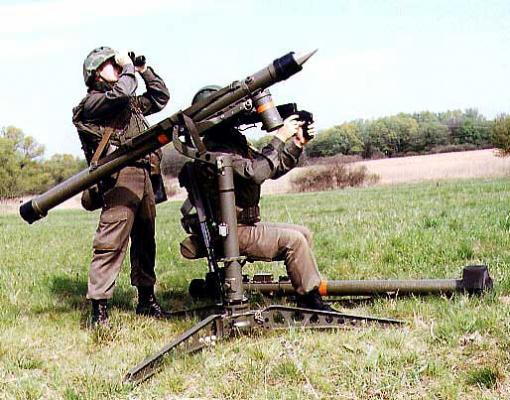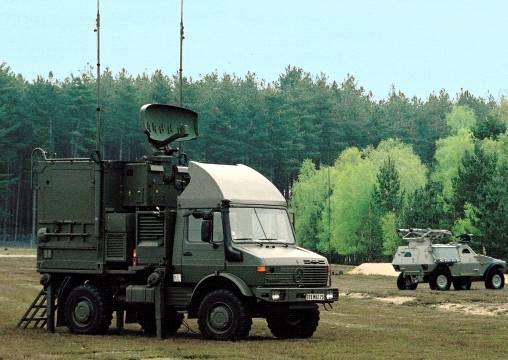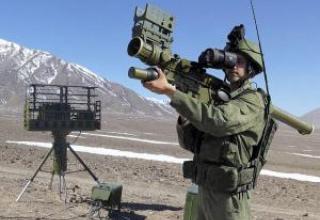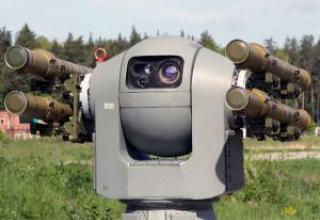The anti-aircraft missile system "Mistral" ("Mistral") is designed to provide direct cover for units of ground forces from aircraft and attack helicopters flying at low and extremely low altitudes. Its creation took into account the shortcomings of other SAMs and increased requirements of modern highly maneuverable combat.
Development of the complex was conducted by the French company "Matra". The main co-executing companies were: "Manufacture de Machines du Haut Rhin SA" - combat unit, "Societe Anonyme de Telecommunications" (SAT) - infrared homing head, "Societe Europeenne de Propulsion" - rocket engine, "Societe Nationale des Poudres et Explosifs" (SNPE) - solid fuel charge.
During the development, the rocket had the following requirements: a single rocket for all variants, independence from the launch method and minimum maintenance. Full-scale work on the SATCP variant was started in 1980. From 1986 to 1988, the French army conducted military tests, which ended with the adoption of the complex in 1988 under the name "Mistral".
At present, more than 16,000 Mistral missiles have been launched.
The Mistral" SAM system of various modifications is in service with the land forces and fleets of 25 states: Belgium, Chile, Cyprus, Estonia, Finland, France, Bulgaria, Indonesia, New Zealand, Oman, Singapore, UAE, etc. The Mistral missile system is in service with the French Army.
In addition to the basic portable version of "Mistral" SAM system, several variants of the complex for different carriers have been developed:
- ALAMO - complex for installation on light vehicle chassis;
- ATLAS - mobile SAM system with a launcher for two missiles;
- ATLAS-RC - a mobile SAM system with a remote-controlled launcher for two missiles;
- ALBI - paired launcher for lightweight self-propelled chassis (can be optionally equipped with night vision and identification systems "own-user");
- ATAM - a helicopter version used as an air-to-air weapon for fighting primarily enemy combat helicopters;
- SANTAL - a tower system for six missiles with a detection radar;
- SIMBAD - ship's SAM system with twin launcher for small displacement ships;
- TETRAL - ship's SAM system for four missiles;
- SADRAL - ship's SAM system for six missiles;
- SIGMA - constructed launcher combined with a 30 mm cannon.
At the Eurosatory exhibition, held in Paris from 12 to 16 June 2006, MBDA Corporation demonstrated a new multi-purpose combat vehicle (MPCV) on the chassis of light armored vehicle VBR, equipped with a SAM "Mistral".
Composition:
The Mistral man-portable air defence system includes a missile in a hermetic transport and launch container (MPC), a tripod with sights, an insider requestor and a power source.
The Mistral" rocket (see photo) consists of a hull, infrared homing head (HID), electronic guidance equipment, electric servomotors for steering, thermochemical battery, fuse, combat unit, marching and dropping launch engines, as well as a self-destruct device. The rocket is made according to the aerodynamic scheme "duck", which provides it with high maneuverability, allowing it to withstand eightfold overloads and get a fairly high accuracy of guidance on the final part of the flight.
The infrared homing head (ICHS) is placed inside a pyramidal fairing. This shape has an advantage over the conventional spherical one, as it reduces the frontal resistance. In the CNS used a mosaic-type reception device made on the indium arsenide (K = 3-5 microns), which significantly increases the ability to detect and capture targets with reduced IR radiation, and also allows you to distinguish between a useful signal from a false one (sun, brightly lit clouds, IR traps, etc.). In addition, to achieve high sensitivity, cooling of the receiving device is used (the refrigerant tank is attached to the trigger). The CLO is capable of capturing and escorting a jet aircraft at a range of up to 6 km, and a helicopter equipped with devices to reduce infrared radiation - at a range of up to 4 km even on counter courses.
Shrapnel - the blast warhead of the missile contains ready-made tungsten spherical attack elements (1500 pieces). The BC is equipped with contact and laser non-contact fuses. The choice of the latter (with a precise distance reference mechanism) made it possible to avoid premature detonation of the combat unit due to interference emitted by local objects, trees, etc. The calculated error value for the range is about 1 m. During range tests, the detonation of a combat unit at such a distance from air targets resulted in defeat.
The requirements to reduce the weight and size of the engine, as well as the order in which it functions and provides the necessary reliability, led the developers to abandon the traditional design of the engine for a ZAR in favor of a more complex technology of its execution, in particular the use of composite materials. The engine of the Mistral RSD consists of two engines; a starting engine and a marshalling engine. The first one is placed in the nozzle part of the marshal engine (see diagram). During the motion of the rocket in the TPK, it informs her initial speed of 40 m / s. The launch engine is equipped with several nozzles that provide rotation of the rocket (10 r/s) to stabilize it in flight. Discovery of the aerodynamic rudders and stabilizer planes occurs when the rocket leaves the launch container. At a safe distance for the operator (about 15 m) the starting engine is thrown off and a marching engine is switched on, informing the rocket the maximum speed M=2.6. Thanks to such a high speed, it reaches the helicopter, which depends on a distance of 4 km from the place of launch, for 6 seconds, which does not allow it to not only use its weapons, but also to take cover behind the natural folds of the terrain.
An advanced version of the missile, designated "Mistral-2", is currently in production.
For easy pointing and starting of the ZUR, the operator uses a tripod with a seat on which the TPC and all the necessary equipment is mounted. With the help of appropriate mechanisms the turn and the necessary elevation angle for firing in almost any direction is provided. When transporting a portable SAM "Mistral" it is divided into two parts (weight of each is about 20 kg): TPK with a rocket and a tripod with sighting devices and an electronic unit. When developing this SAM, special attention was paid to reducing the time for its deployment and reloading. According to the data of the conducted tests on installation of the TPK on a tripod and bringing the complex into combat position takes about 1 minute, on switching on the SOS (gyroscope deployment and IR sensor cooling) takes 2 seconds. The average reaction time (from the launch chain activation to the rocket launch) is about 5 s in the absence of external target designation data and 3 s in the presence of such data. It takes about 30 s to recharge.
The sighting device consists of a collimator and a telescopic sight. Using the collimator readings, the operator can take into account vertical and horizontal pre-emptive angles. Mistral" portable SAM system is equipped with "own - alien" identification equipment and a thermal imaging device to ensure firing in night conditions. The trigger mechanism includes the following elements; a battery to power the electric circuits, a cylinder with a refrigerant, a switching device that provides the necessary sequence of commands and signals, an indicator with an audible and vibrating device, triggered when signals from the target are captured by the missile's homing head. To operate in night conditions, the complex can be equipped with a thermal imager of the MATIS type manufactured by "Sagem" or MITS-2 by "Thales Optronics".
The MCP (Mistral Coordination Post) was first shown at the 1991 Paris Air Show. The MCP is designed to be used with a portable Mistral system, ATLAS or ALBI systems for air defense of military units and important facilities.
The MCP includes:
- Fire detection and control radar with "Oerlikon Contraves" SHORAR identification system ,
- Combat control station,
- information transfer unit to firing positions,
- an information exchange system with a superior command post.
The MCP provides target designation and fire control for eleven "Mistral", ALBI or ATLAS man-portable air defence systems in any combination. The MCP is mounted on a Panhard VBL 4x4 chassis or any other off-road chassis. MCP is adopted by NATO countries and exported to Oman.
Characteristics:
| Defeat zone, m: - at a distance - in height |
500-6000 5-3000 |
| Maximum target speed, km/h. | 1500 |
| Rocket Speed, M | 2.6 |
| Flight time at maximum range, s | 14 |
| The length of the rocket, mm | 1860 |
| The diameter of the rocket body, mm | 90 |
| Missile launch weight, kg | 18.7 |
| Weight of combat unit, kg | 3 |
| Weight of warhead explosive charge, kg | 1 |
| Weight of the rocket in the TPC, kg | 24 |
| Temperature range of warfare | -45°C to +70°C |
Testing:
Of the more than 50,000 launches of Milan missiles (training and combat missiles) carried out in various conditions, 92% ended in a direct hit. The effectiveness of the complex was demonstrated in combat conditions: Iraq since 1980, Syria and Great Britain in 1982, French troops in Lebanon in 1984, Chad in early 1987. With nine PU units of the Chadian land forces hit more than 100 tanks and other vehicles in Libya, using about 250 missiles "Milan-2".
Sources:
- В.Викторов "Французский ЗРК "Мистраль" , Зарубежное военное обозрение N 4, 1987 год
- Mistral Air Defence Missile System, France /www.army-technology.com/
- Mistral /www.deagel.com/












